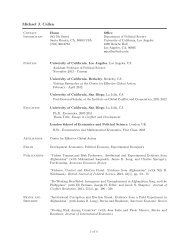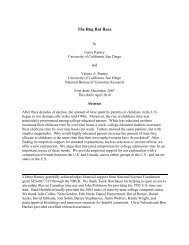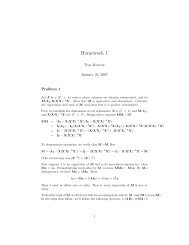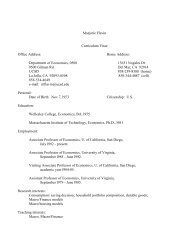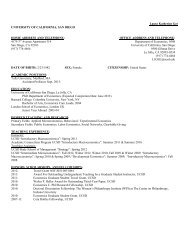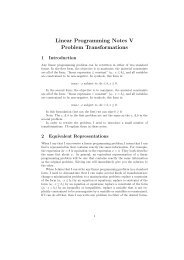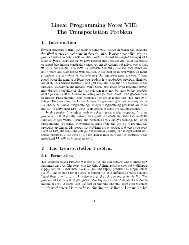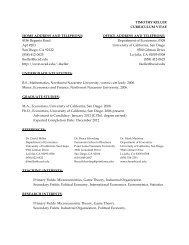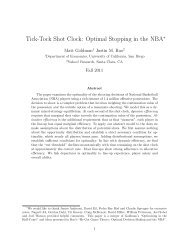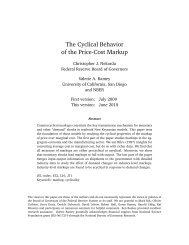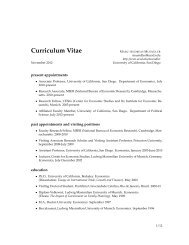Endogenous derivation of 'money' - UC San Diego Department of ...
Endogenous derivation of 'money' - UC San Diego Department of ...
Endogenous derivation of 'money' - UC San Diego Department of ...
Create successful ePaper yourself
Turn your PDF publications into a flip-book with our unique Google optimized e-Paper software.
458 R. M. Starr<br />
2 Formalizing menger’s ‘origin <strong>of</strong> money’<br />
Why is there money? is one <strong>of</strong> the classic issues in the foundations <strong>of</strong> economic<br />
theory, with contributions extending from Smith’s Wealth <strong>of</strong> Nations, to the present.<br />
Money, like written language and the wheel, is one <strong>of</strong> the fundamental discoveries<br />
<strong>of</strong> civilization. Nevertheless, despite the evident superiority <strong>of</strong> monetary trade over<br />
barter, there is a puzzling quality to monetary exchange. Monetary trade involves<br />
one party to a transaction giving up something desirable (labor, his production, a<br />
previous acquisition) for something useless (a fiduciary token or a commonly traded<br />
commodity for which he has no immediate use) in the hope <strong>of</strong> advantageously<br />
retrading this latest acquisition. An essential issue at the foundations <strong>of</strong> monetary<br />
theory is to articulate the elementary economic conditions that allow this paradox<br />
to be sustained as an individually rational market equilibrium.<br />
Over a century ago, Carl Menger presented the paradox <strong>of</strong> monetary trade as a<br />
challenge to monetary theory and proposed an outline <strong>of</strong> its solution, a theory <strong>of</strong><br />
liquidity as the basis <strong>of</strong> monetary theory, Menger (1892):<br />
It is obvious ... that a commodity should be given up by its owner ...for<br />
another more useful to him. But that every[one] ... should be ready to exchange<br />
his goods for little metal disks apparently useless as such...or for<br />
documents representing [them]...is...mysterious... why...is...economic<br />
man ...ready to accept a certain kind <strong>of</strong> commodity, even if he does<br />
not need it,... in exchange for all the goods he has brought to market[?]<br />
[Call] goods ... more or less saleable, according to the ... facility with<br />
which they can be disposed <strong>of</strong> ... at current purchasing prices or with<br />
less or more diminution... Men ... exchange goods ... for other goods<br />
... more saleable....[which] become generally acceptable media <strong>of</strong> exchange<br />
[emphasis in original].<br />
Menger’s proposed solution focused on the liquidity <strong>of</strong> commodities. A good is<br />
very saleable (liquid) in Menger’s definition above, if the price at which a household<br />
can sell it (the market’s prevailing bid price) is very near the price at which it can<br />
buy (the market’s prevailing ask price). In this setting, price theory includes a theory<br />
<strong>of</strong> liquidity. The segmented market creates a demand for a carrier <strong>of</strong> value between<br />
transactions. Separate bid and ask prices represent transaction costs and put a price<br />
on liquidity: a good’s bid/ask spread is the price <strong>of</strong> using it as a medium <strong>of</strong> exchange.<br />
Hence, a good with a uniformly narrow bid/ask spread is highly liquid – in Menger’s<br />
word ‘saleable’ – and constitutes a natural ‘money.’ Price theory implies monetary<br />
theory. Liquidity creates monetization. This is the insight that will be formalized<br />
in the examples below.<br />
Starting from the non-monetary Arrow-Debreu model, two additional structures<br />
are sufficient to give endogenous monetization in equilibrium: multiple budget<br />
constraints (one at each transaction, not just on net trade) and transaction costs.<br />
One way <strong>of</strong> formalizing multiple budget constraints is a trading post model. Thus,<br />
if there are N goods actively traded, there are N(N − 1)/2 possible trading posts.<br />
That is the starting point <strong>of</strong> the examples below. The choice <strong>of</strong> which trading<br />
posts a typical household will trade at is part <strong>of</strong> the household optimization. The




